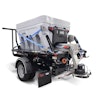Hertz Global Holdings, Inc. (NYSE: HTZ)
(with its subsidiaries, the "Company" or "we") reported second quarter 2012
worldwide revenues of $2.2 billion, an increase of 7.4% year-over-year (a
10.3% increase excluding the effects of foreign currency). Worldwide car
rental revenues for the quarter increased 6.8% year-over-year (a 9.9% increase
excluding the effects of foreign currency) to a record $1,889.6 million.
Revenues from worldwide equipment rental for the second quarter were $335.0
million, up 11.0% year-over-year (a 13.1% increase excluding the effects of
foreign currency), driven by an 18.8% revenue increase in the U.S. and 15.2%
in North America.
2
Second quarter 2012 adjusted pre-tax income was a record $233.9 million, versus $184.4 million in the same
period in 2011, and income before income taxes (“pre-tax income”), on a GAAP basis, was $158.7 million,
versus $94.6 million in the second quarter of 2011. Corporate EBITDA(1) for the second quarter of 2012 was
a record $407.7 million, an increase of 12.6% from the same period in 2011.
Second quarter 2012 adjusted net income(1) was a record $154.4 million, versus $116.6 million in the same
period of 2011, resulting in record adjusted diluted earnings per share for the quarter of $0.35, compared with
$0.26 for the second quarter of 2011. Second quarter 2012 net income attributable to Hertz Global Holdings,
Inc. and subsidiaries’ common stockholders, or “net income,” on a GAAP basis, was $92.9 million or $0.21
per share on a diluted basis, compared with $55.0 million, or $0.12 per share on a diluted basis, for the second
quarter of 2011.
Mark P. Frissora, the Company's Chairman and Chief Executive Officer, said, “We delivered strong revenue
and earnings growth again in the second quarter of 2012, and achieved several record results, despite moderate
global GDP growth. Our second quarter 2012 results are a testament to fostering a culture of continuous
improvement as we delivered a 390 basis point improvement in direct operating expenses and $107 million in
incremental efficiency savings for the quarter.”
Net cash provided by operating activities was $666.4 million in the second quarter of 2012, compared to
$521.3 million in the same period last year, an increase of $145.1 million. The increase was primarily due to
an increase in net income before depreciation and amortization. Additionally, corporate cash flow(1) improved
by $107.8 million, primarily due to increased advance rates on our fleet debt and earnings before depreciation
and amortization, partially offset by an increase in our equipment rental fleet spend associated with our
3
continued growth and the timing of fleet payables associated with additions to our U.S. car rental fleet. The
Company ended the second quarter of 2012 with total debt of $12.5 billion and net corporate debt (1) of $4.11
billion, compared with total debt of $11.7 billion and net corporate debt of $4.01 billion as of June 30, 2011.
Despite overall net REE growth of $885 million, the total debt increase was limited primarily to the addition
of $879 million in debt associated with Donlen's fleet. Net corporate debt increased $100 million, but
excluding proceeds paid for acquisitions since June 30, 2011 it would have declined over $275 million.
WORLDWIDE CAR RENTAL
Worldwide car rental revenues were a record $1,889.6 million for the second quarter of 2012, an increase of
6.8% (a 9.9% increase excluding the effects of foreign currency) from the prior year period. The Company
achieved record transaction days for the quarter which increased 7.0% over the second quarter of 2011 [10.1%
U.S.; 0.1% International]. U.S. off-airport total revenues for the second quarter increased 12.5% year-overyear,
and transaction days increased 17.4% from the prior year period. Worldwide rental rate revenue per
transaction day(1) (“RPD”) for the quarter decreased 3.4% [(3.1)% U.S.; (3.2)% International] from the prior
year period. RPD continues to be impacted by the shift in our mix between airport and off-airport rentals.
When adjusted for mix, second quarter U.S. RPD decreased 1.9%. Growth in off-airport rentals, and
specifically growth in replacement rentals, which have longer rental lengths, has a negative impact on RPD.
However, it is important to note that off-airport’s profit contribution is growing significantly. U.S. airport
RPD benefitted from a 1.4% increase in airport leisure pricing, but this was more than offset by continued
pressure on commercial pricing and in the deep value segment, where new competitors are aggressively
discounting rentals. In Europe, improved pricing in commercial rentals is being more than offset by negative
pricing for leisure rentals, where demand is softest.
Worldwide car rental adjusted pre-tax income for the second quarter of 2012 was a record $277.4 million, an
increase of $35.2 million from $242.2 million in the prior year period. The result was driven primarily by
increased volume, strong cost management performance and lower net depreciation per vehicle, partially
offset by a decrease in RPD. As a result, worldwide car rental achieved a record adjusted pre-tax margin(1) of
14.7% for the quarter, versus 13.7% in the prior year period.
The worldwide average number of Company-operated cars for the second quarter of 2012 was 656,200, an
increase of 34.7% over the prior year period, largely as a result of the Donlen acquisition, and a 4.6% increase
year-over-year excluding the effects of the Donlen acquisition.
Commenting on the results of the Company's car rental business, Mark Frissora said, "U.S. rent-a-car
continues to generate record operating results and we are especially pleased by the performance of the
Advantage brand which grew revenues approximately 42% in the second quarter."
WORLDWIDE EQUIPMENT RENTAL
Worldwide equipment rental revenues were $335.0 million for the second quarter of 2012, an 11.0% increase
(a 13.1% increase excluding the effects of foreign currency) from the prior year period, driven by an 18.8%
revenue increase in the U.S. and 15.2% in North America.
Adjusted pre-tax income for worldwide equipment rental for the second quarter of 2012 was $42.5 million, an
improvement of $9.1 million from $33.4 million in the prior year period, primarily attributable to the effects of
increased volume and pricing and cost management initiatives. Worldwide equipment rental achieved an
adjusted pre-tax margin of 12.7% and a Corporate EBITDA margin(1) of 37.7% for the quarter. Worldwide
4
equipment rental Corporate EBITDA margin of 37.7% was negatively impacted 180 basis points due to
insurance claims reserves and legal expenses.
The average acquisition cost of rental equipment operated during the second quarter of 2012 increased by
8.1% year-over-year and net revenue earning equipment as of June 30, 2012 was $2,030.0 million, compared
to $1,911.1 million as of March 31, 2012.
OUTLOOK
The Company reaffirms its full year 2012 revenues, Corporate EBITDA, adjusted pre-tax income, adjusted net
income and adjusted diluted earnings per share guidance provided on May 2, 2012. The Company expects to
generate worldwide revenues in the range of $8.9 billion to $9.0 billion, Corporate EBITDA in the range of
$1.60 billion to $1.66 billion, adjusted pre-tax income in the range of $870 million to $940 million, adjusted
net income in the range of $570 million to $620 million and adjusted diluted earnings per share in the range of
$1.28 to $1.38 (based on 450 million shares).(2)
RESULTS OF THE HERTZ CORPORATION
The Company's operating subsidiary, The Hertz Corporation ("Hertz"), posted the same revenues for the
second quarter of 2012 as the Company. Hertz’s second quarter 2012 pre-tax income was $171.7 million
versus the Company’s pre-tax income of $158.7 million. The difference between Hertz’s and the Company’s
results is primarily due to additional interest expense recognized by the Company on its 5.25% Convertible
Senior Notes issued in May and September 2009.
(1) Adjusted pre-tax income, adjusted pre-tax margin, Corporate EBITDA, Corporate EBITDA margin, adjusted net income,
adjusted diluted earnings per share, corporate cash flow, net corporate debt and rental rate revenue per transaction day are non-
GAAP measures. See the accompanying Tables and Exhibit for the reconciliations and definitions for each of these non-GAAP
measures and the reason the Company’s management believes that these measures provide useful information to investors
regarding the Company’s financial condition and results of operations.
(2) Management believes that Corporate EBITDA, adjusted pre-tax income, adjusted net income and adjusted diluted earnings per
share are useful in measuring the comparable results of the Company period-over-period. The GAAP measures most directly
comparable to Corporate EBITDA, adjusted pre-tax income, adjusted net income and adjusted diluted earnings per share are (i)
pre-tax income and cash flows from operating activities, (ii) pre-tax income, (iii) net income, and (iv) diluted earnings per share,
respectively. Because of the forward-looking nature of the Company’s forecasted Corporate EBITDA, adjusted pre-tax income,
adjusted net income and adjusted diluted earnings per share, specific quantifications of the amounts that would be required to
reconcile forecasted cash flows from operating activities, pre-tax income and net income are not available. The Company
believes that there is a degree of volatility with respect to certain of the Company’s GAAP measures, primarily related to fair
value accounting for its financial assets (which includes the Company’s derivative financial instruments), its income tax
reporting and certain adjustments made to arrive at the relevant non-GAAP measures, which preclude the Company from
providing accurate forecasted GAAP to non-GAAP reconciliations. Based on the above, the Company believes that providing
estimates of the amounts that would be required to reconcile the range of the non-GAAP Corporate EBITDA, adjusted pre-tax
income, adjusted net income and adjusted diluted earnings per share to forecasted cash flows from operating activities, pre-tax
income, net income and diluted earnings per share would imply a degree of precision that would be confusing or misleading to
investors for the reasons identified above.
















